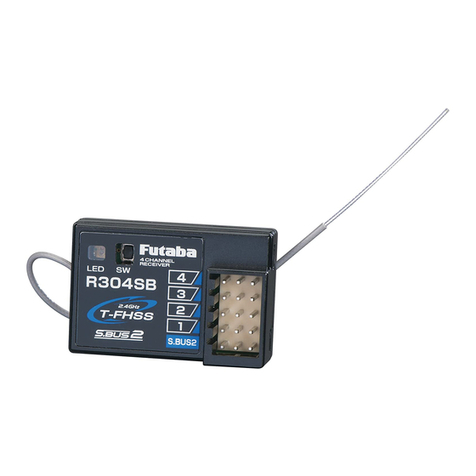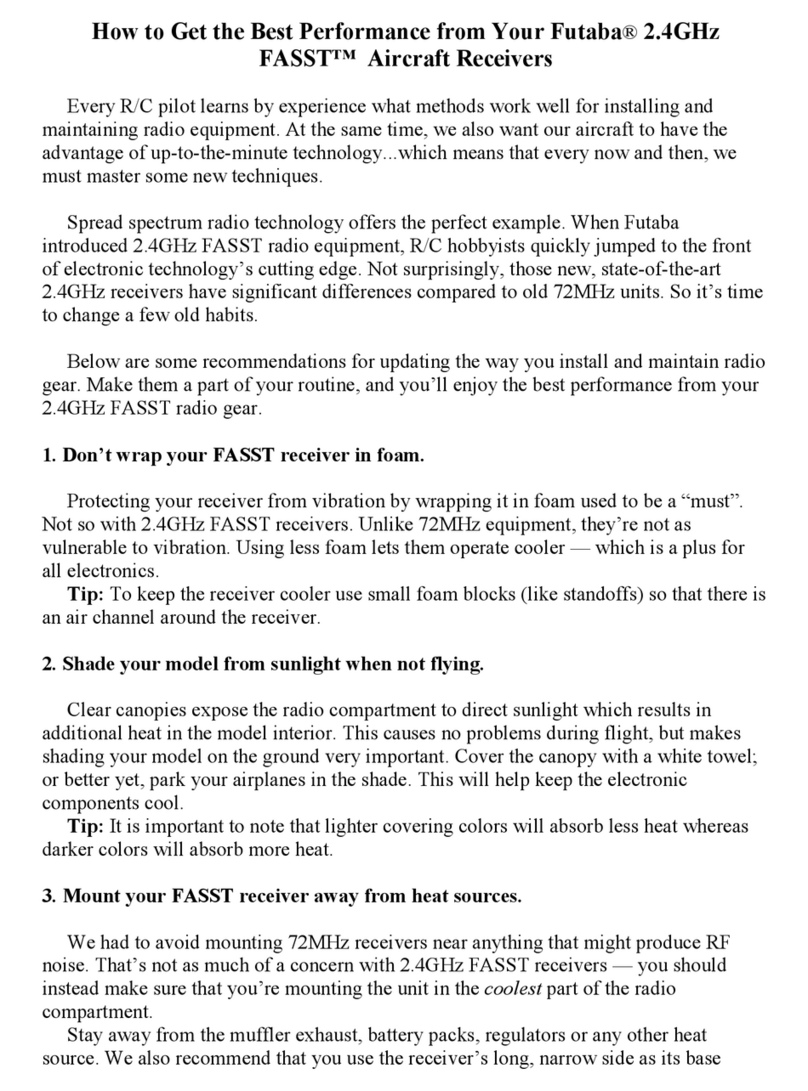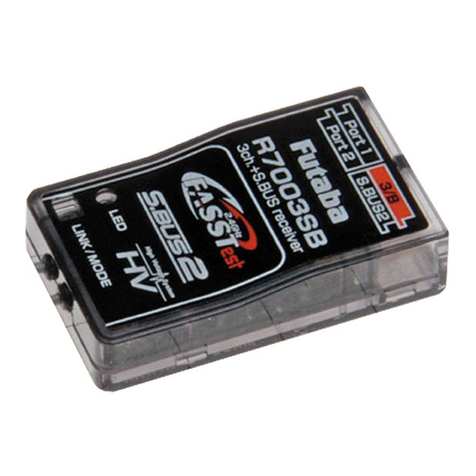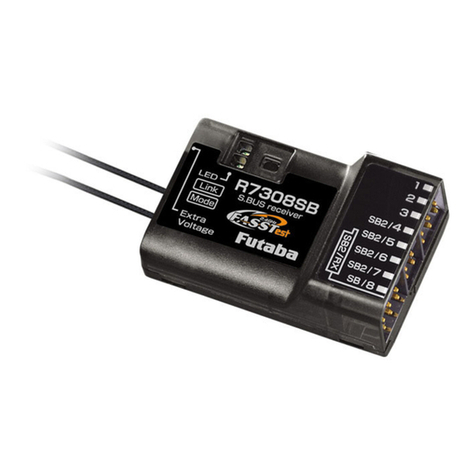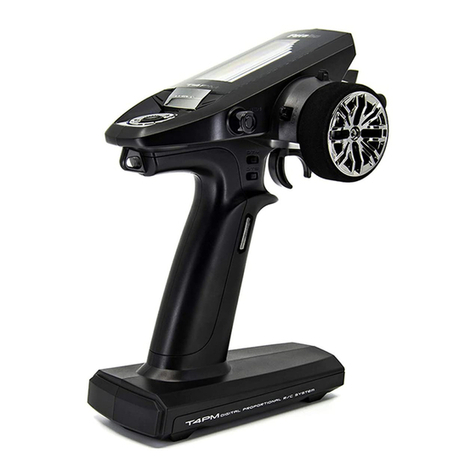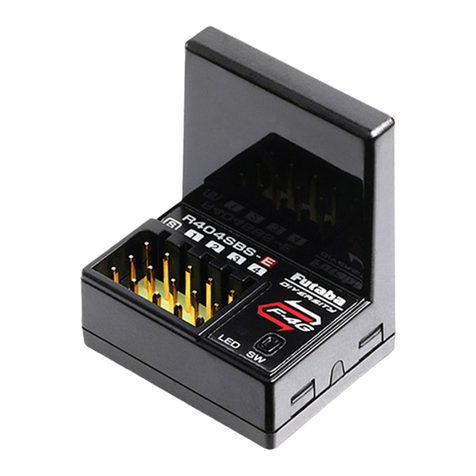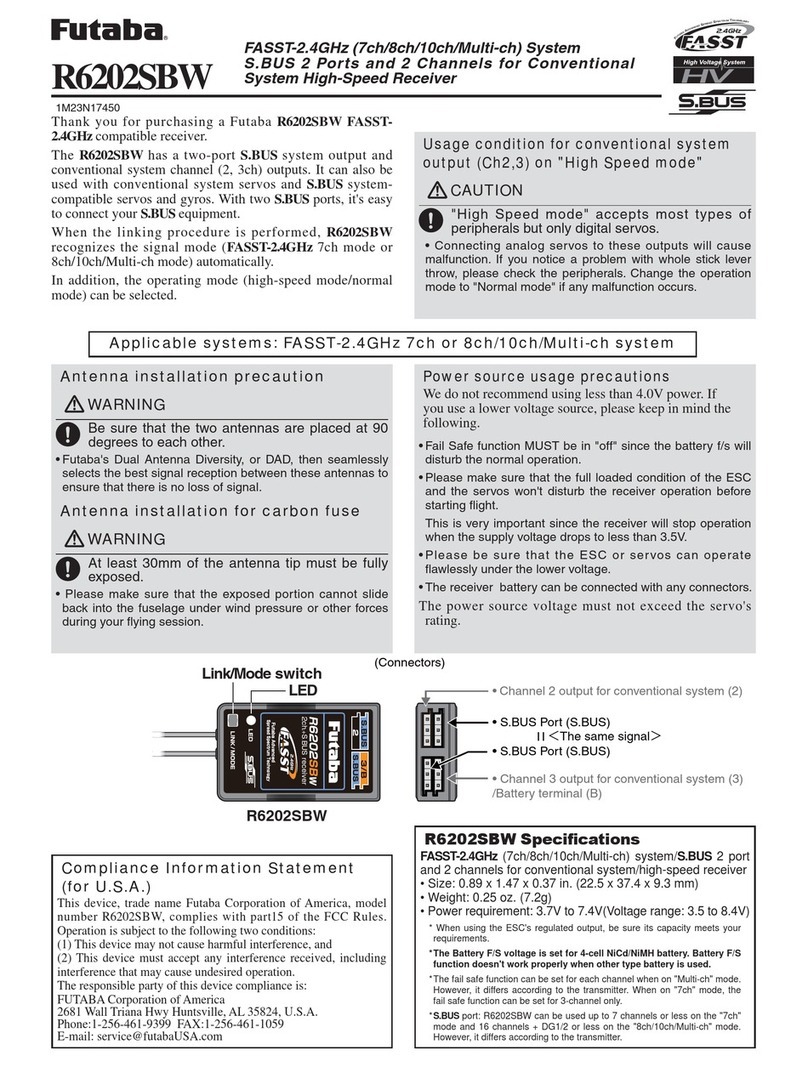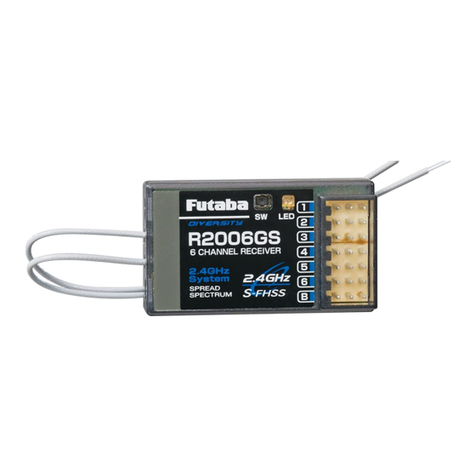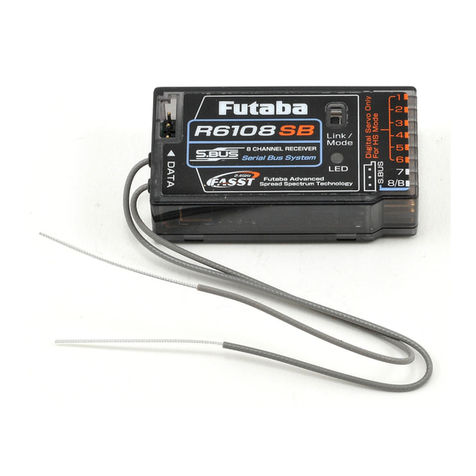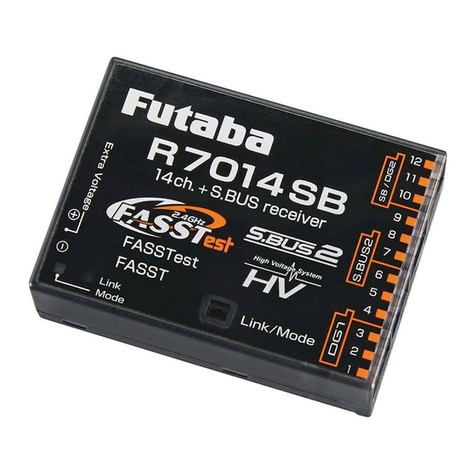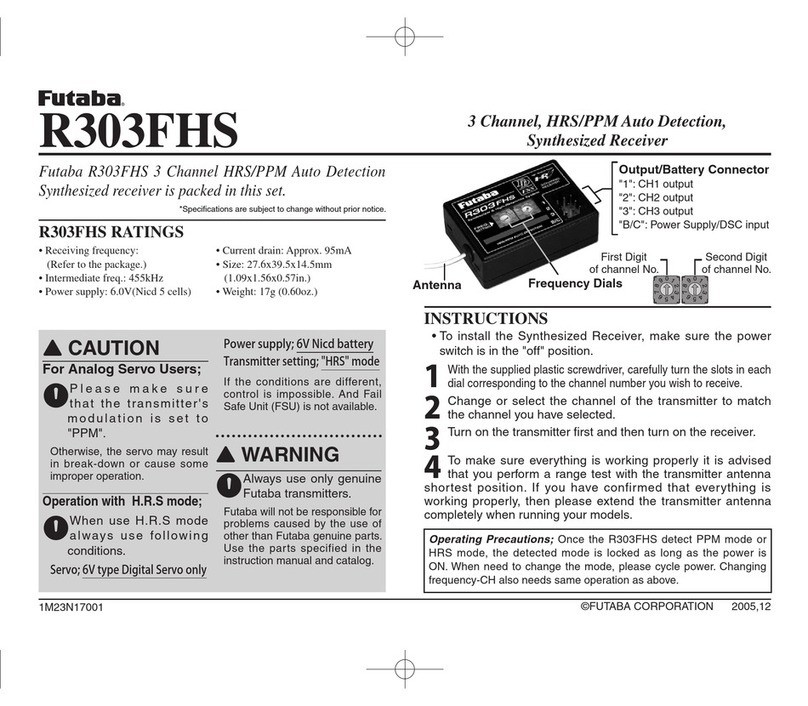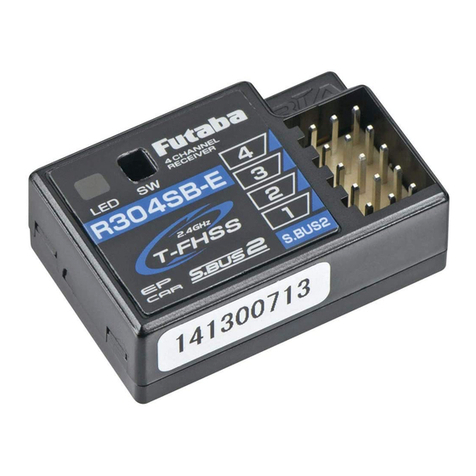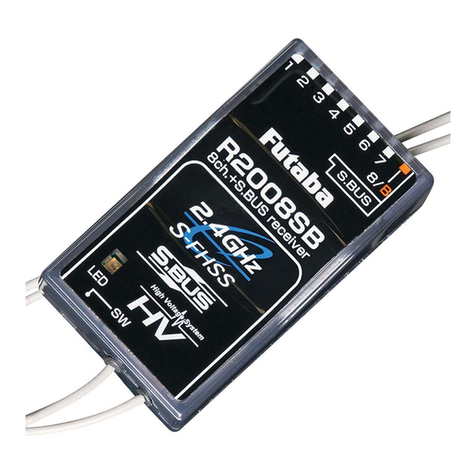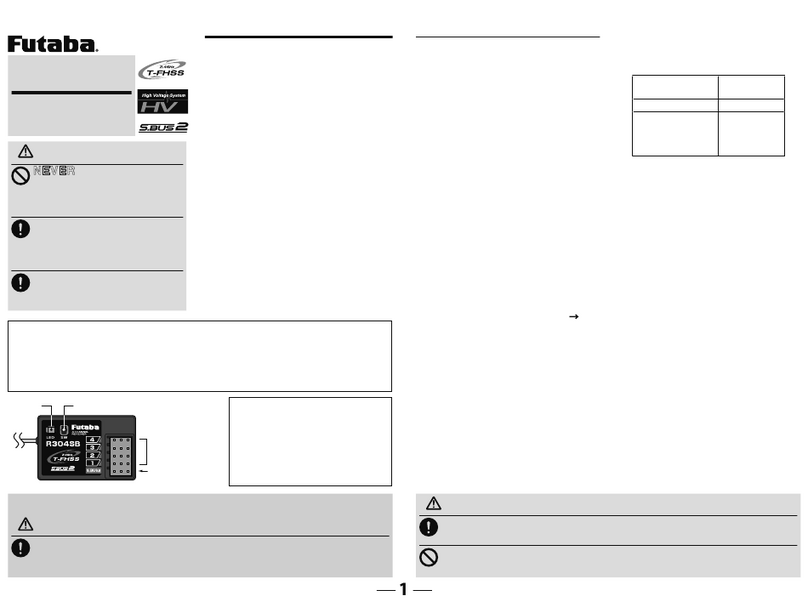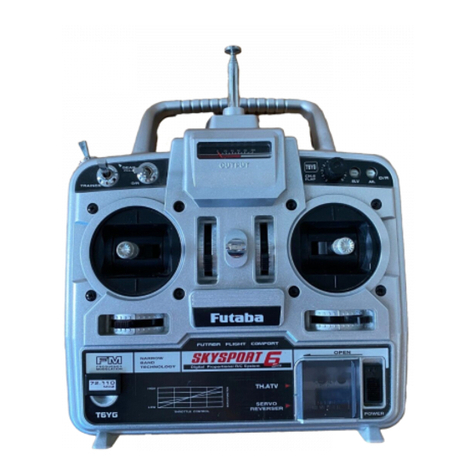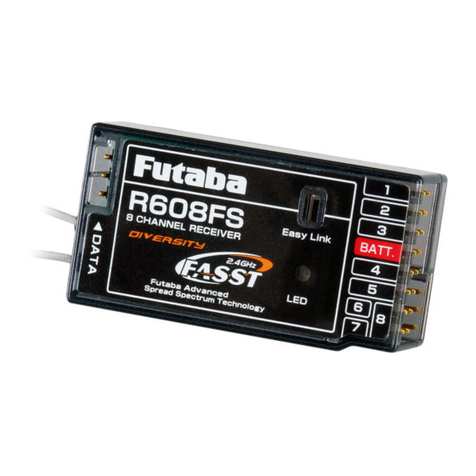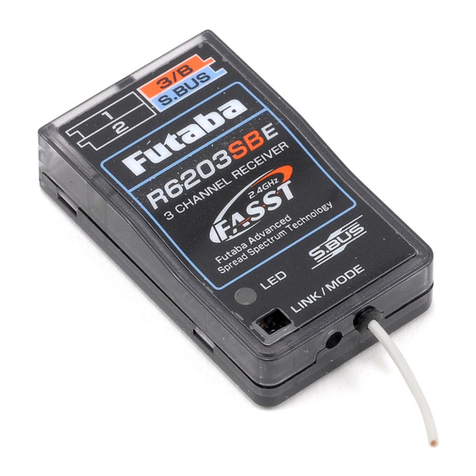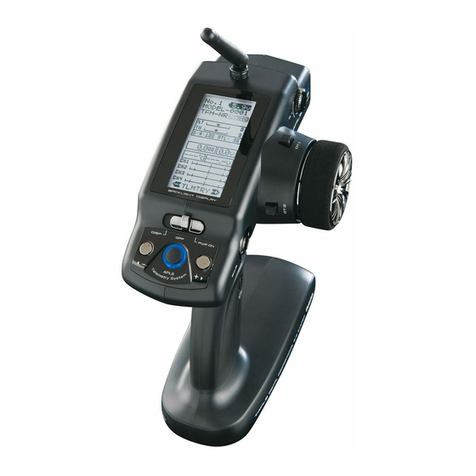Important: The 2.4GHz band offers different characteristics than
that of the conventional 50MHz and 72MHz. As such, we strongly
encourage you to read this manual carefully prior to utilizing the TM-7
and R607FS FASST system.
1M23N19802
Contents and Technical Specications
Your 2.4GHz system includes the following components:
Specications:
TM-7 RF Module-
•Communication system: one-way communication
•Antenna: 1/2 wavelength di-pole
•Current consumption: 150mA maximum
•Setting switch for Fail Safe (F/S) setting and range check
•LED (light emitting diodes) indicate the operational status
R607FS Receiver-
•Dual antenna diversity
•Power requirement: 4.8V or 6.0V battery or regulated out-
put from ESC, etc.
•F/S and Battery F/S function for throttle channel (channel
three)
•Size: 1.64 x 1.08 x 0.36 in. (41.6 x 27.5 x 9.2 mm)
•Weight: 0.34 oz. (9.8g)
TM-7 RF Module
FASST Air System
TM-7 RF Module
and
R607FS Receiver
Thank you for purchasing the TM-7 2.4GHz FASST transmitter module
and R607FS receiver. This system is designed for use only with the
Futaba transmitters indicated elsewhere in this manual. In order to use the
TM-7 transmitter module, you will need to carefully remove the existing
transmitter module and replace it with the TM-7 transmitter module. The
receiver R607FS, as the model number indicates, is capable of controlling
models up to seven channels. Please note: The installation of the R607FS
differs slightly from that of a typical receiver. Please pay special attention
to the information contained within this manual in order to have a pleasant
ying experience.
Features:
2.4GHz Spread Spectrum radio communication system.
Exclusive ID code to avoid interference from other FASST systems.
Fail Safe (F/S) function (for throttle channel)-F/S, Battery F/S
Dual antenna diversity (R607FS)
•
•
•
•
Applicable systems:
T7U, T8U, T9C and T9Z
R607FS Receiver
Mini screwdriver
Instruction Manual
Repair Service (in U.S.A.)
If any difculties are encountered while setting up or operating
your TM-7 transmitter module and R607FS receiver, please
consult this instruction manual first. For further assistance
you may also refer to your hobby dealer, or contact the Futaba
Service Center at the web site, fax or telephone number below:
www.futaba-rc.com, www.2.4gigahertz.com
Fax (217) 398-7721, Tel (217) 398-8970 (option 2)
If you are unable to resolve the issue, pack the system in its
original container with a note enclosed and a thorough, accurate
description of the difculty. Include the following in your note:
Symptoms (Including when the problem occurred)
System (transmitter, Receiver, Servos and model
numbers)
Model (Model name)
Model numbers and quantity
Your Name, Address and Telephone number
Send the respective items to the authorized Futaba Service
Center address below:
Futaba Service Center
3002 N Apollo Drive Suite 1
Champaign, IL 61822
•
•
•
•
•
Battery F/S function
The TM-7 transmitter module and R607FS receiver also
provides you with a second safety system, the Battery F/S
(failsafe). When the airborne voltage drops below 3.8V, the
battery failsafe function moves the throttle to a pre-determined
position. If this happens, you should land immediately! If
you need to increase the throttle for your landing approach,
you may temporarily reset the failsafe function by moving the
throttle stick to the predetermined position, after which you'll
have about 30 seconds of throttle control before the battery
function reactivates.
* Please note: It is suggested that you utilize a 4-cell NiCD or NiMH
receiver battery pack as it allows the effective use of the battery F/S
function. Additionally, we do not suggest using dry cell batteries for
the receiver pack as they may cause difculties.
Range Check the Radio
It is extremely important to range check your models prior to
each ying session. This enables you to ensure that everything
is functioning as it should and to obtain maximum enjoyment
from your time flying. The TM-7 transmitter module
incorporates a system that reduces its power output and allows
you to perform such a range check.
1Turn on the transmitter.
2 After the radio frequency link has been established
(as indicated by either a solid green LED or a
blinking green LED), press and hold the "F/S, Range"
switch located on the rear of the TM-7 transmitter module.
As indicated by the blinking red LED, the radio frequency
power has been reduced to allow for the range check.
* Note: Do not press and hold the "F/S, Range" switch prior to turning
on the transmitter. This will alter the status of the F/S settings as
noted previously. In order to avoid this situation, please wait for a
short time after turning on the transmitter to activate the low power
setting on for range checking.
3
Walk away from the model while simultaneously
operating the controls. Have an assistant stand
by the model to confirm that all controls are completely
and correctly operational. You should be able to walk
approximately 30-50 paces from the model without losing
control.
4
If everything operates correctly, return to the model.
Set the transmitter in a safe, yet accessible, location
so it will be within reach after starting the engine or motor.
Be certain the throttle stick is in the low throttle position,
then start the engine or motor. Perform another range
check with your assistant holding the aircraft with the
engine running at various speeds. If the servos jitter or
move inadvertently, there may be a problem. We would
strongly suggest you do not fly until the source of the
difficulty has been determined. Look for loose servo
connections or binding pushrods. Also, be certain that
the battery has been fully charged.
WARNING
Please make sure that you do not push and hold the F/S,
Range switch when flying as this reduces the power
output of the transmitter and reduces the overall range of your
transmitter.
Other precautions
When utilizing the trainer function of the transmitter as an
instructor, please do not switch to the student's control
unit until the RF is active after turning the transmitter
on. Failure to adhere to this procedure may result in a
malfunction.
Usage Precautions:
1) Prior to utilizing any radio control system, it is strongly recommended
that you read and abide by the Safety Code created by the Academy of
Model Aeronautics as well as any site specific rules and regulations that
might exist. Doing so will greatly increase your enjoyment of the hobby.
2) In order to maintain complete control of your aircraft it is important that
it remains visible at all times. Flying behind large objects such as build-
ings, grain bins, etc. is not suggested. Doing so may result in the reduc-
tion of the quality of the radio frequency link to the model.
3) Please do not grasp the transmitter module's antenna during flight. Do-
ing so may degrade the quality of the radio frequency transmission.
- 4 - - 1 -
FASST transmitter module, system and receiver
compatibility
Transmitter Receiver
R606FS R607FS
TM-7 Module — Okay
T6EX 2.4G System Okay Okay
T7C 2.4G System Okay Okay
* Please note:The TM-7 module is NOT compatible with the R606FS receiver!
©Copyright 2007. No part of this manual may be reproduced in any form without prior permission. The contents of this manual are subject to
change without prior notice. While this manual has been carefully written, there may be inadvertent errors or omissions. Please contact our service
center if you feel that any corrections or clarications should be made.
FUTABA CORPORATION Phone: (043) 296-5118 Facsimile: (043) 296-5124
Makuhari Techno Garden Bldg., B6F 1-3 Nakase, Mihama-ku, Chiba 261-8555, Japan
©FUTABA CORPORATION 2007, 07 (1)
FCC Information
To assure continued FCC compliance:
(1) Any changes or modications not expressly approved by the grantee
of this device could void the user's authority to operate the equipment.
FCC Label Compliance Statement:
This device complies with Part 15 of the FCC Rules. Operation is subject
to the following two conditions: (1) this device may not cause harmful
interference, and (2) this device must accept any interference received,
including interference that may cause undesired operation.
